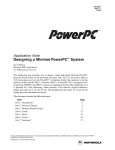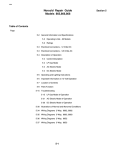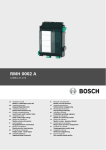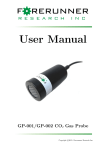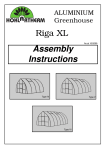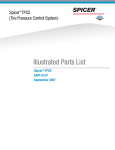Download Virtex Proto Board - The Lab Book Pages
Transcript
LEARNING THE ROPES Ingo Cyliax Virtex Proto Board Windows. I’m sure you’ve been there at one time or another. Someday they’ll bring out these design tools under Linux. At least I can dream. My design environment under Windows is a mess, but the Linux environment on my laptop still works well, enabling me to write this article. This month, I’ll talk about the Virtex prototyping board I’m using for the project that got me in trouble— the Virtual Workbench 300 (VW-300) from the Virtual Computer Corporation (VCC). THE BOARD I Although Ingo had originally planned to follow up his last article about multipliers, he ran into a little problem. OK, so it was a big problem. But, that’s to our benefit. www.circuitcellar.com/online The board is a prototyping board for the Xilinx Virtex series FPGA. Virtex is Xilinx’s high-end FPGA, boasting densities of up to one million gates (more in the Virtex-E). Remind me to write a piece about how to compute realistic gate densities in FPGAs that actually mean something. Virtex has some nice architectural features that make it suitable for large system-on-a-chip designs that include 32-bit processor cores, peripherals, and high-performance digital signal processing. There are several types of memory from SelectRAM that can be used for small register files (i.e., BlockRAM), which are large 4-Kb originally planned to follow my last piece with an article about how to design with multipliers. Well, to shorten the story, the software I intended to use in designing some of the multiplier examples didn’t work. The longer version of the story is that, because I was working on a project, I needed to upgrade my FPGA design software to the latest and greatest version. Of course, because it runs under Windows, this doesn’t always work the way you think it will. Such was the case with the new installation, so I decided to downgrade to the original version. Unfortunately, it doesn’t work at all now. At this point, I needed to uninstall both versions by removing all traces of .dlls, executables, environment variables, and registry entries, or just resort to reinstalling Photo 1—Look at all this neat stuff on such a small board. CIRCUIT CELLAR ® ONLINE July 2000 1 Standard Input Ref. Voltage Output Source Voltage Termination Voltage LVTTL LVCMOS PCI GTL GTL+ HSTL Class I HSTL Class III HSTL Class IV SSTL3 Class I/II SSTL2 Class I/II CTT AGP N/A N/A N/A 0.8 1.0 0.75 0.75 0.75 1.5 1.125 1.5 1.32 3.3 2.5 3.3 N/A N/A 1.5 1.5 1.5 3.3 2.5 3.3 3.3 N/A N/A N/A 1.2 1.5 1.5 1.5 1.5 1.5 1.125 1.5 N/A Table 1—Here is a list of all the I/O interfaces that can be supported by Virtex. Each bank’s VIO and VREF power supplies can be wired to various voltages to help implement these. RAM modules available on-chip. BlockRAMs are highly flexible because they can be configured as either single- or dual-ported memory with either 1 or 16-bit wide ports. Other than that, they are of the look-up table-based CLB architecture, with plenty of routing resources to connect them with fast carry support between adjacent CLBs. The I/O on Virtex chips is perhaps the best feature. There are several banks of I/O, each bank powered by its own I/O power supply and input reference voltage. With the appropriate power supplies, various signaling standards can be implemented. Table 1 shows the supported types. Of course, the inputs are also 5-V tolerant if it’s selected and have programmable pull up/pull down and weak keepers. To make interfacing even easier, Virtex has several delay locked loops (DLL). These can be used to match internal clock signals to external clocks in order to reduce the effects of on/off chip latencies at high clock rates. NO RE-FLOW OVEN? Virtex FPGAs are available in BGA packages. BGA packages are the package of choice for large chips these days. Of course, like many new package styles, they are harder to mount when prototyping or building one-offs. BGAs have small solder balls on the bottom of the chip that match up 2 July 2000 with small solder pads on the PCB. The BGAs are placed on the PCB and then need to be heated in an oven for the solder balls to melt and bond with the solder pads. Of course everyone has a re-flow oven these days. Because I don’t have a re-flow oven handy and didn’t have enough time to track down a facility that could handle mounting these packages, I had to buy a prototype board for this project. The project, incidentally, was demonstrating a 32-bit processor core I developed for my day job. I needed a Virtex board with a large enough chip and some external memory pre-wired, along with a prototyping area for all the extra stuff. After searching Optimagic’s web site, which is great for FPGA resources, I found that the VW-300 fit the bill, so I ordered one. Besides the Virtex chip, the VW300 has a lot of memory, a clock, and connector resources. In addition, there are LEDs, switches, push buttons, 8digit alphanumeric LED display, and other neat stuff all on an 5.5″ × 5.5″ board (see Photo 1). There are three memories on the VW-300. A 256K × 8-bit flash memory is used to store startup configuration for the FPGA. From the factory, it has a demo that scrolls continual advertising over the alphanumeric display. It’s nice to have something running so you can make sure everything is OK (after you’ve taken it out of the box and built a power supply). The flash CIRCUIT CELLAR ® ONLINE memory can be reprogrammed by removing it from its socket (it’s PLCC footprint flash memory) and programming in a programmer. A CPLD is used to interface the flash memory to the Virtex part to perform Xilinx’s SelectMAP partial reconfiguration protocol. Because the CPLD is flash memory-based, I suppose it could be reprogrammed to perform other functions. BURST MODE Besides the flash memory, the VW-300 also has a 256K × 18-bit synchronous burst mode fast static RAM (SBRAM). This is a memory module normally used for off-chip L2 processor cache and supports burst mode operations. The cycle time of the memory installed is 6 ns (166 MHz), which means it can transfer at a peak rate of over 332 MBps. Because the SRAM is fast but not too large, an 80-ns 1M x 16 x 4 SDRAM is also included onboard. The SRAM and DRAM memories are devices attached to the FPGA. By itself, the Virtex does nothing special with the memories. You would have to design in a SRAM or DRAM controller into the design loaded on the FPGA in order to use the memory. In this project, you can use the SDRAM as traditional program and data memory, and the SRAM as fast buffer memory or cache memory. The Xilinx web site has cores that can be used to control burst mode SRAM and SDRAM in a Virtex design. Because the Virtex also has on-chip memory block and small look-up table-based register files, you can use a full spectrum of memory hierarchy—from small single- and dualported register files (SelectRAM) running at sub-nanosecond access times, to larger memory block (BLOCKRAM) running at less than 5ns access times. To get to off-chip memory, you have to figure the latency it takes to get in and out of the chip and protocol issues, in addition to the access times of the memory. For example, to access SBRAM you have to send the address and wait for the data to burst out of the memory sequentially. Although the peak burst www.circuitcellar.com/online buffers, which can diagram of the internal display. cause fights if not You can use this display to show a CLK properly designed, hexadecimal representation of inter*W you can actually nal registers, assuming you add logic *E overheat the chip at to your design to use the display. You normal operating can also use it to provide a small An SA temperatures. A scrolling text console for your project. temperature sensor Besides onboard peripherals, there DQ D(An) D(An+1) D(An+2) D(An+4) can be used to deare a variety of headers and connectect these conditors that can be used to interface exFigure 1—Here you can see the timing diagrams for SBRAM access. tions and shutdown ternal modules, devices, and logic rate is fast at 166 MHz, the total access the chip if the temperature exceeds analyzer inputs to the Virtex on this time to get four words is at least five safe levels. I suppose a boring applicaboard. In particular, there are several cycles. Figure 1 shows timing diagrams tion of a temperature sensor might be mezzanine connectors for third party for SBRAM access. In contrast, to drive a variable speed fan to cool CODEC modules from Insight, as BlockRAM works as true random acthe chip optimally. well as A/D and D/A Omnibus modcess memory, not in burst mode. In any If you’re building systems on a ules from Innovative Integration. All case, with this board you have all the chip, you might want to use serial of the I/Os are documented in the options covered. communication channels to talk with user manual, and pin configuration other computers or a terminal. This files for the FPGA can be downloaded board includes a TTL to RS-232 level MORE OPTIONS from VCC’s web site. adapter and a DE-9 connector to perThe VW-300 also has several clockThere are several configurations ing options. It has two Dallas Semicon- form this. For example, this project that are supported on this board for uses an RS-232 port for a background ductor DS1073 econo-oscillators (100 the Virtex chip. I already mentioned MHz and 66 MHz). These can be set up debugger type interface. the flash PROM for doing SelectMAP Building a UART in FPGA is not to divide the oscillator frequency by configuration, and there are jumpers two, which is the default. In addition to hard. I used to teach students in unand headers for serial PROM, JTAG, dergraduate hardware labs to do this. these oscillators, the board has a CyXchecker, and MultiLINX configuraI’ll cover designing UARTs in a later press ICD2053B adjustable oscillator, tion. The manual, schematics, and which can be programmed using a serial article. datasheet for some of the components If you like switches and lights, it protocol either from the FPGA or exterare available on the web site. After nally. By default, this oscillator runs at has those as well. There is an 8-posiyou have registered for your board, tion DIP switch and eight surface16 MHz. As if this isn’t enough, there everything you’d expect from a mount LEDs you can read and light up prototyping board opens up to you. is also an extra oscillator site where with the FPGA. There are also four you can install your own oscillator pushbutton switches. However, the module. UPON ARRIVAL Another neat feature is the tempera- neatest peripheral on this board is the After the board arrived, it became ture sensor module. This is a Max1617 Infineon IPD2133 8-character 5 × 7 obvious that I was missing somedot matrix die temperature sensor. The Virtex provides a diode-based die temperature aphanumeric display. To the FPGA, the output that works with this sensor module. The module converts the tem- display looks like a small SRAM device. perature reading and lets you read the There is an address temperature through a SMBUS interface, either by the FPGA or externally. bus and a data bus. The simplest way to Measuring the die temperature is use it is to address useful for several reasons. Because FPGAs are user programmable, comput- one of the eight digits (address 0–7) and ing power consumption (and power write a 7-bit ASCII dissipation) is complex. During system testing, you can use the die temperature, code to it. The chip converts the ASCII and by knowing the ambient air temcode using an interperature as well as heat transfer coeffinal character ROM cients for the package and current air and displays it on the humidity, you can estimate the power 5 × 7 array for that consumption and power dissipation. Also, because this type of Virtex has digit. Not bad. Figure Photo 2—After the voltages were adjusted and everything was hooked up, I was ready to try it out. so many flip-flops and internal tristate 2 shows a block www.circuitcellar.com/online CIRCUIT CELLAR ® ONLINE July 2000 3 thing. It turns out that Ingo Cyliax is the Sr. OSC the Virtex chip is a 2.5Hardware Engineer at V core logic device. Derivation Systems Row Drivers That means all of the Inc. (DSI) where he div 7 div 32 internal logic on this designs and builds div 128 chip operates from a embedded systems and 2.5-V power supply. hardware components. ROM Virtex-E FPGA core DSI is the leader in ROM Chal: RAM Chal: word D Latch div 3 Decode RAM actually runs at 1.8 V. formally synthesized decode Furthermore, most of FPGA cores and speChal: decode the memories and pecializes in embedded ODC ripherals work at 3.3 V Java technology. Ingo RAM Chal: Data bus decode and some, like the RShas been writing on 232 converter, run from various topics ranging Figure 2—The internal display has an address bus and data bus and provides you with many a 5-V supply. However, from real-time operatoptions for use. there are no onboard ing systems to nuts regulators. VCC does have a matching Figure 3. Photo 2 shows what this and bolts hardware issues for several looks like. power supply available for this board years. Because the VIN/VOUT differential that takes care of it all. Building power supplies isn’t has to be between 1.5 and 5.75 V, I SOURCES rocket science (for the most part), so I chose a small 5-V switcher that I Virtual Workbench 300 (VW-300) figured it shouldn’t be a big deal. Esscrounged up from an old Macintosh. Virtual Computer Corporation pecially, because voltage regulators After carefully adjusting the two volt(818) 342-8294 don’t come in BGA packages, and I ages (3.3 and 2.5 V), I hooked up evFax: (818) 342-0240 can solder these parts myself. Taking erything you see in Photo 2 and tried www.vcc.com a quick survey however, I discovered it for the first time. It was nice to see that 3.3-V regulator ICs are readily the demo design come up the first OptiMagic’s Programmable Logic available and 2.5-V regulators are time. The compiled project was Jump Station harder to come by. I settled on using downloaded through an Xchecker Optimagic Linear Technologies’ LT-1587. These cable and everything came up as ex(831) 687-0415 devices are available in varied fixed pected with the board. Fax: (408) 701-7007 voltages, as well as an adjustable verAlthough I’m typically a strong www.optimagic.com sion. I chose the adjustable version advocate of building your own stuff, that is available in three terminal TO- it’s nice to be able to use off-the-shelf 220 packages and quickly cobbled up a prototyping boards. Usually when I power supply on a perforated circuit build my own boards, I spend a sigboard that matches the schematics in nificant amount of time debugging my aspect of the design. In this case, it was definitely a 5v timesaver, especially because it will probably take several 5v 3.3v attempts to fine-tune any LT1584 BGA-based home assembly 125 10µF 220µF techniques. I did figure out that my kitchen stove (203.8) achieves re-flow temperatures in “clean” mode. Apparently 2.5v LT1584 the normal thermostatic control is disabled in this 220µF 125 10µF mode, and the oven runs up to its maximum temperature. (124.3) At this point, however, I’m hesitant to try a re-flow with a $300 FPGA in my kitchen VOUT = VREF (1+ R2/R1) + Ladj R2 VREF = 1.25 V oven. If I take on such a task Ladj. = 55µA Circuit Cellar, the Magazine for Computer Applications. in the future, I’ll be sure to Reprinted by permission. For subscription information, let you know whether or not Figure 3—Here you can see a schematic of the power supply I call (860) 875-2199, [email protected] or quickly threw together. I’m successful. I www.circuitcellar.com/subscribe.htm. 4 July 2000 CIRCUIT CELLAR ® ONLINE www.circuitcellar.com/online






